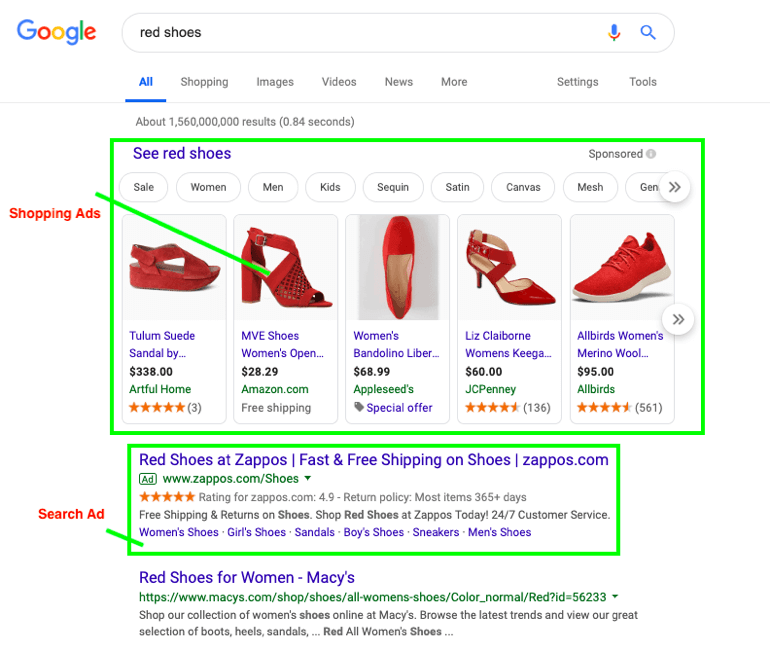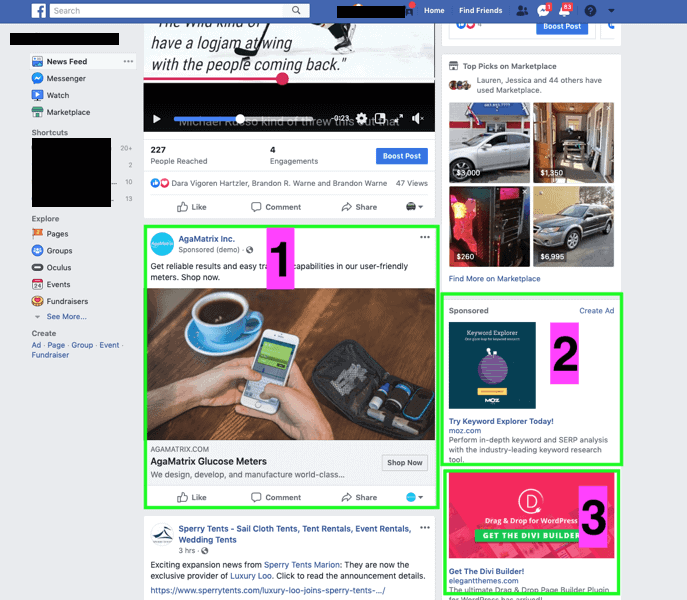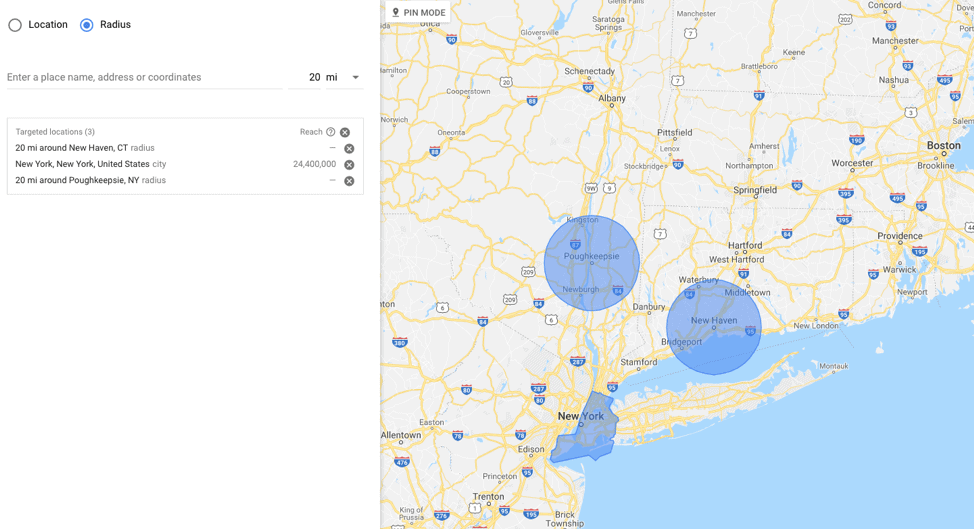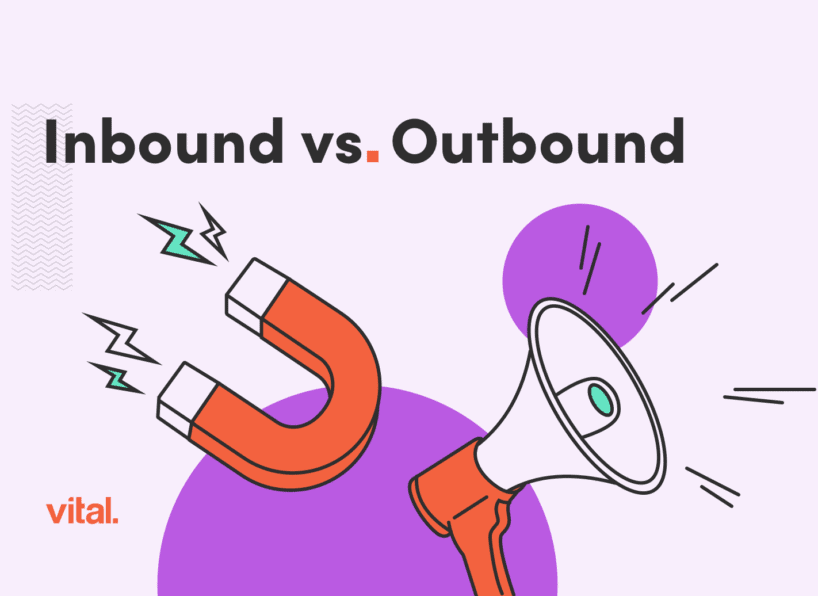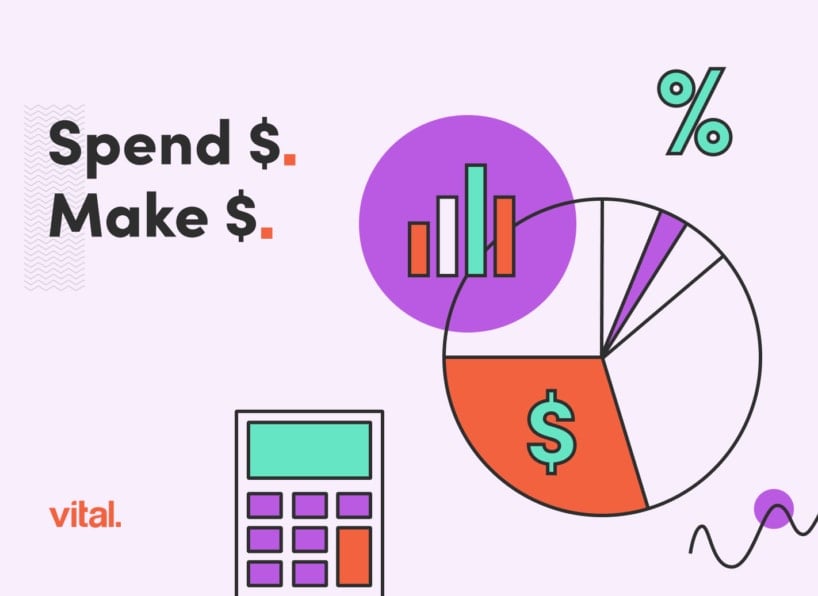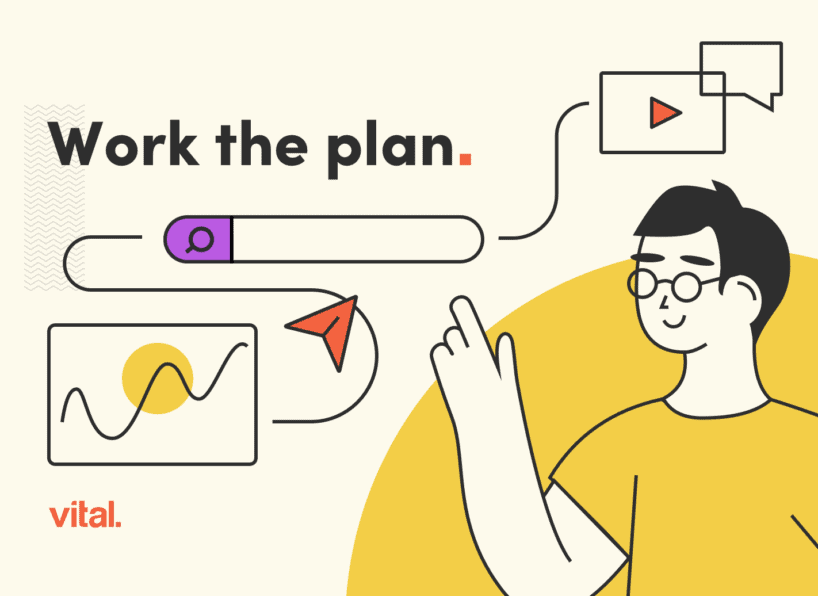What is Pay-Per-Click Marketing (PPC)?
PPC stands for pay-per-click, which is a form of online advertising where advertisers pay each time a user clicks on an advertisement online. These advertisements can be displayed in many forms; within search results, on display banners, before a video plays, etc. Advertisers place bids on certain search terms, known as keywords, to make their ads appear when someone searches for that term. The price of these bids is determined by keyword search volume, relevance and other factors.
The most common type of paid advertising is a search ad. These ads appear when people search for items, questions or phrases online using a search engine like Google. This could be anything from “Chinese food near me” to a local service search (someone looking for carpet cleaning) to someone shopping for a gift (Valentine’s Day flowers) to larger purchases such as enterprise business software. Basically, a wide majority of searches on Google will trigger paid search ads to appear because businesses want to showcase their offerings to you. Other forms of PPC advertising include remarketing, product listing ads (PLAs or Shopping Ads) and display.
Types of Paid Advertising
Paid Search
This is a form of advertising that uses search engines to advertise text ads. When a person uses a search engine to find information on Google, Bing or Yahoo, they may see ads on top of search results that are relevant to their search query.
Paid Display
This is a form of advertising that uses various websites and mobile app networks to advertise image ads. When a user is visiting different websites online, they may often come across a website that allows advertisers to display image ads on the website.
Paid Video
Google allows advertisers to show ads on YouTube. These ads can be displayed in numerous different formats. They can show before a video plays, during the video (if applicable), on the sidebar feature video and suggestions list, as a semi-transparent overlay on the lower portion of a video, as video cards or as a non-skippable format that must be watched for up to 6 seconds before skipping.
Paid Shopping
Google allows advertisers to serve shoppable ads that appear above the search results within the search engine results page (SERP). These ads are called Product Listing Ads (PLAs) that showcase an image of a company’s product. They can also feature other attributes that help boost engagement like price, customer reviews and promotions.
Paid Social Media
This form of advertising uses social media platforms (Facebook, Instagram, Twitter, Pinterest, LinkedIn) to advertise to users. When a user is browsing on the platform, they may receive personalized ads based on their interests, habits and online behaviors.
Types of Paid Advertising Platforms
Google Ads
Google uses search, display and video advertising. Search ads use Google’s search engine to serve ads on, whereas Google display and video ads use their display network and YouTube to showcase ads to users.
Bing Ads
As the second largest search engine, Bing Ads uses both Search and Display advertising. Search Ads are served on Bing’s search engine and Display ads serve on Bing’s display network.
Facebook Ads
Facebook ads use their social media platform to display ads throughout their extended network. Ads are shown on the Facebook timeline, Facebook stories, Instagram feed and Instagram stories. Facebook ads can be created using image, video, carousel and collection ad types. From these ad categories Facebook then utilize different ad formats.
The types of ad formats are as follows:
- Video
- Image
- Collection
- Carousel
- Slideshow
- Instant Experience
- Lead Gen
- Offer
- Post Engagement
- Event Responses
Facebook Advertising Goals
- Brand Awareness
- Prospecting
- Lead Generation
- Product or Offer Promotion
LinkedIn Ads
LinkedIn uses their network to showcase ads to users based on numerous targeting factors such as job titles, company industries, experience level, geographic location and interests.
The types of ad formats are as follows:
- Video
- Image
- Job Listing
- Sponsored Content
- Sponsored InMail
LinkedIn Advertising Goals:
- Brand Awareness
- Prospecting
- Lead Generation
- Product or Offer Promotion
Twitter Ads
Twitter uses their network to drive awareness by promoting tweets to maximize reach, promote retweets, likes and replies. Utilizing a sponsored tweet can help to drive traffic to your website if you are publishing content linked to a blog post, eBook or other offer. Twitter utilizes geographic and interest targeting.
Pinterest Ads
Pinterest uses their network to drive awareness of products by utilizing shopping related ads as well as promoted pins to help drive traffic to your website. Pinterest if great for targeting users at an early stage in the buyer’s journey. Users are often in the discovery phase while researching ideas for a project and can have the opportunity to stumble upon your product to learn more.
What PPC Strategies Are There?
Prospecting
Allows advertisers to capture a larger audience base that can target users interests, demographics (age and gender), previous website actions, and other targeting options to find new prospective customers.
Remarketing
Allows advertisers to re-engage website visitors with ads that direct them back to specific pages of your website to complete an action (download eBook, contact sales, purchase item, etc.). The main purpose of these ads are to drive awareness of the products and services that you offer to increase returning website traffic in hopes that it will later convert. It’s one way to help nurture leads further down the marketing funnel.
How Prospecting Can Be Used
Prospecting can be used to attract new business or new audiences who have similar characteristics as your target market and current customer base. These criteria can be a variety of qualities that range from purchase behavior to demographics to interests to job titles, etc.
Paid Search – Allows advertisers to show their ads on Google’s search engine, whenever a user types in a search query that relates to a keyword the advertiser is bidding on.
Paid Display – Allows advertisers to target specific websites through a visual display ad that has a clear call-to-action driving the user to your website. These ads can be in either a static or responsive format. Display ads are shown on various websites through Google’s display network.
Paid Social Media – Similar to paid search & display, paid social allows targeting of specific interests, behavioral trends, demographics and other metrics, but are typically shown within a social media platform such as LinkedIn & Facebook.
How Remarketing Can Be Used
Remarketing allows advertisers to serve ads (usually in the form of a display image or HTML5) on other websites to people who previously visited your website. Remarketing is a widespread online advertising strategy that allows advertisers to help drive back lost website visitors in hopes they return to your website and make a purchase or any other action. Us marketers like to call these conversions.
Utilize Different Audiences
Creating different audiences (we like to call them “pools”) can help further expand your remarketing strategy. Not everyone who visits your website is going to be interested in your remarketing ad. Instead of taking a generalized approach by creating a broad offer and remarketing to all website visitors, you can target specific groups of website traffic who may have viewed a blog post, looked at specific products, or took action (downloaded an eBook or whitepaper) on your site.
These audience sizes range depending on the duration of traffic you allow members to be on your list. The maximum duration for an audience list is 540 days. At Vital, we create audiences that range from 30 – 360 days from the time someone has visited a website. The size of the audience should depend on the messaging and goal of the campaign.
Once you have your audience pool defined, you can serve these people customized ads in hopes that the personalization and messaging will be more targeted on their intent for visiting your website. Thus, they are more likely to take further action (hopefully a purchase) when they return.
Create Remarketing Funnels
Creating a remarketing funnel is another step to having a more personalized advertising strategy. Basic remarketing funnels are based off previous website actions and can range from utilizing all website traffic down to single web page views.
A basic remarketing funnel works by bucketing users who viewed specific pages of your website together. A group who view three or more product pages, spend more than one minute on a product page, and view three or more blog posts in one website session can be bucketed together in a “warm leads pool” based off of website behavior.
If anyone in this pool clicks back on your offer, they will get placed into a secondary bucket and will later on get served a new remarketing offer, and so on, and so on. Thus pushing users further down a remarketing funnel with different offers in hopes that it leads them to take action.
Remember the goal of a successful remarketing campaign should be to bring the user back to your website and have them take action. Hopefully that action is a purchase!
Keyword Research
Keyword research requires finding search terms that are relevant to a business’s products and services. Advertisers can utilize numerous tools to perform this. Our favorites are:
- Google Keyword Planner
- SEMrush
- SpyFu
Keywords help identify what relevant terms are meaningful to a business. Ask yourself “how much does that word mean to my business?” The higher the search volume (number of searches on a search engine per month) the more valuable that keyword will be as it will potentially drive more traffic to your website. You should also weigh in on the competition of each keyword and the amount you are willing to bid.
To avoid spending money on keywords that don’t matter to your business, try to identify the WHY or the intent behind people searching for a term. These keywords should align with your business goals and either be targeted or broad depending on the direction and budget of your strategy.
Generally, the more expansive the keyword list, the more budget you will need to allocate bids across a large volume of keywords, if there is search volumes behind them. The more refined the list is while also allowing for newer search terms to filter in, the more room you make for account expansion over time.
Audience Research
Understanding your target audience is vital (no pun intended) to PPC success. Knowing what pain points, interests, demographics and actions your customers take and potential customers take will help better cater ads and keywords to your target audience. You should have a deep understanding of who you would like to target before setting up any type of PPC campaign.
Keyword Match Types
Keywords and their prospective match type(s) allow any advertiser the majority of control over an account. Broad match keywords are going to bring in the majority of search terms that have wide variations of your keyword. Think of this strategy as “casting the largest net possible.”
As you start to utilize phrase and exact match keywords, you begin to limit your potential reach with new search terms that may come in that focus on relevant, high intent keywords.
There are many different strategies to go about choosing match types but if you want a broad range with tons of volume and want to drive clicks, choose broad match. If you’re more conversion focused and want to limit the number of longer tail keywords and broader terms that come in then I would choose phrase match or exact match keywords.
Every keyword must be assigned a match type, which defines the search terms (queries) for which ads will show. There are several keyword match types:
Exact – Query must be typed in exactly
Exact (Close Variant) – Query must be typed in exactly, but can include misspellings or other variants
Phrase – Query must be typed in correct order, even if there are additional terms before or after the query
Phrase (Close Variant) – Query must be typed in correct order, even if there are additional terms before or after the query. Query can include misspellings or other variants
Broad – Query can be typed in any order and will potentially show ads for similar searches
Modified Broad – Query can be typed in any order, but must include terms that contain a plus sign
Broad (Session-Based) – A form of broad match that takes into account other queries from that user’s search session
Keyword Optimizations
An experienced advertiser will have a full understanding of the relationship between a keyword, ad copy, and landing page experience. If your accounts keywords are highly relevant and the messaging is clear between the ad copy and landing page, Google will reward that advertiser with lower costs-per-click and a higher Quality Score. The higher the intent the better click-through rates and CPCs you should expect to see overtime.
Based on what keyword modifier(s) you decide to choose, you can either cast a ‘large or small net’ of opportunity. Using only exact match keywords ([cherry red picnic tables]) will result in lower volumes of traffic and your ad will only serve for that term exactly, resulting in a ‘small net’ of opportunity.
On the flip side, casting a larger net, using only broad match or broad modifier keywords (+red +shoes) will allow ads to serve to wider variety of search queries on Google’s search engine. This can easily become costly, inefficient, and allow your ads to serve on a limited basis.
For example, let’s say you have a $10 daily budget (a fairly limited budget) on a campaign that is targeting the keyword “navy blue watches.” This term brings in a good amount of traffic according to Google’s Keyword Planner. With a $10 per day budget, your campaign will quickly run out of budget earlier in the day and you will not be able to serve ads throughout the entirety of the day due to serving on all broad related terms. If you target more exact match queries, your ads will only serve if the user types in exactly that keyword you are bidding for and will result in less click volume, giving your campaign a chance to spend through the entire day.
Bidding Models & Strategies
Manual CPC – A bidding strategy that allows you the most control. But with more control comes more responsibilities when managing your keyword bids, so be careful!
This strategy allows you to manually set each one of your keyword bids based on many factors. These factors include ad position, first page bid estimates, top of page bid estimates and more. You can also set a maximum bid for an ad group that will automatically apply to all keywords. A max CPC bid will act as a threshold for your keywords.
Enhanced CPC – An automated bidding strategy that allows Google to raise a keyword bid for you if it believes that the click will convert. Your maximum bid using this bid strategy can be up to 30% higher when your ad is competing for a spot on the search engine results page (SERP).
If Google does not think that your ad will convert then your bid is decreased in the auction. The last part of the Enhanced CPC bidding feature is that your bid will stay at or below the maximum bid you set for certain auctions. Google’s algorithms evaluate the data and adjust bids. Enhanced CPC bidding can be great for larger accounts where you have a high volume and keywords to manage. But be cautious, as this method can prove to increase your cost per click overtime if you’re not carefully monitoring bids and competition.
Strategies Explained:
Target Search Page Location – This flexible bidding strategy changes bids so your ads can be consistently shown either at the top of the page or on the first page of the SERPs. This strategy is great when your goal is to maximize the number of people who see your ads but can become quite costly when serving top of page depending on the keywords you are bidding on.
Target CPA – This strategy sets bids to maximize conversions at your target cost-per-acquisition. This strategy works well when wanting to keep costs down while growing conversions. In order to run this strategy effectively, you need volume from your ads. You will need to have an accurate cost-per-acquisition value before proceeding with this method.
Maximize Clicks – A flexible bid strategy that will set bids to help you get as many clicks as possible while maintaining spend. This strategy is useful when click volume is the primary goal.
Target Return on Ad Spend (ROAS) – Some businesses, particularly eCommerce, place higher value on certain conversions over others. The target ROAS is a strategy that sets bids to maximize conversions within a target ROAS goal.
Maximize Conversions – Google requires a minimum of 15+ conversions in a one month time span for it to gather enough data to optimize your campaigns to make informative decisions. The main goal of this strategy is to push your campaign budget to its maximum value if Google sees an opportunity where conversions are more likely.
To summarize, manual bidding allows the advertiser more control over their account while more automated bidding strategy allows you to be less in the driver’s seat. This means less management hours for you, but can become costly over time if you let bids get out of hand.
Bidding Models Explained
Last Click: Gives all credit for the conversion to the last-clicked ad and corresponding keyword.
First Click: Gives all credit for the conversion to the first-clicked ad and corresponding keyword.
Data-driven: Distributes credit for the conversion based on past data for this conversion action. (This is only available to accounts with enough data).
Position Based: Set keyword bids based on overall average position that a client wants to achieve. For example, a running shoes company wants all of their ads to show in the number two spot on Google’s SERP. A PPC manager will adjust the keyword bids to bid-to-position so that the price of each bid will be at a 2.0 position or around that value.
- Want to see this in action? See how we decreased keyword bids across an account to help decrease overall cost-per-click and lower their cost/conversion in just two months!
Auction Insights (The Competition)
Within Google Ads, you can view all other advertisers auction keyword data which both you and the competition are bidding on. You can view this at a campaign, AdGroup and keyword level, depending on volume. Two main factors that help determine where you stand among the competition are impression share percentage and average position. If you have a high impression share percentage, your ads are serving as much as possible, given your budget. How high your bids are will dictate your ad position if you are using a position based bidding model. If you bid top-of-page, you will most likely have an average position of a 1.5 or higher. If you bid on the first page of search results you will most likely have a 2.0 – 3.0 position. See example below: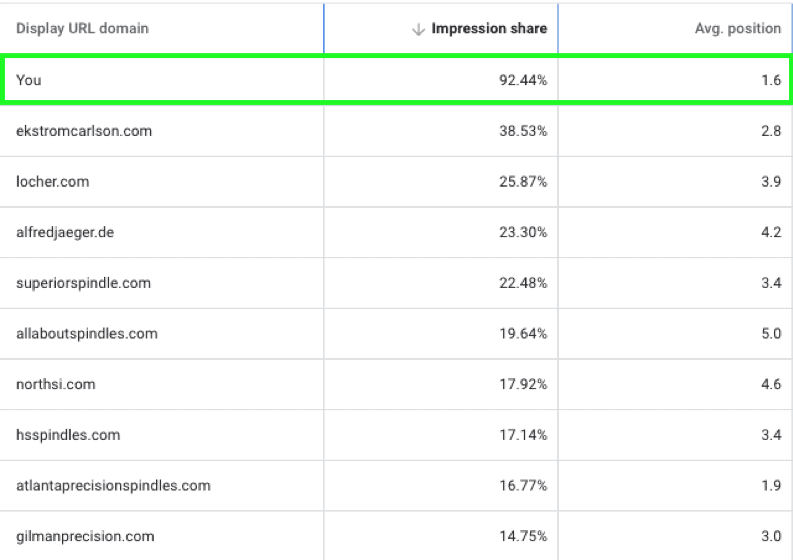
Ad Format & Objective Types
Overall Objective
- Awareness
- Engagement
- Lead Generation
Search – To capture intent behind performing a search on a search engine.
Display – To visually promote and offer ads that will nurture a prospect or win them back to your website.
Expanded Text Ads
Expanded text ads are made up of three different headlines (up to 30 characters each), two descriptions (up to 90 characters each), a final URL and two display paths. See example below.
This format allows advertisers the most real estate on the search engine to entice users to click on their ads.
Responsive Search Ads
Responsive Search Ads are Google’s newest (currently in beta) and most automated search ad format. Unlike traditional search ads, where you create your headlines and descriptions to create a single static ad, responsive ads allow you to write up to fifteen different headlines and up to four different descriptions. This lets Google test your ad variations for you. Overtime, Google will learn which variations perform the best and serve these ad variations more often than other combinations. It takes data from keywords, search terms, device and previous browsing history into consideration. No more creating multiple ads to A/B test, let Google do the work for you. Start showing highly relevant ads to your potential customers.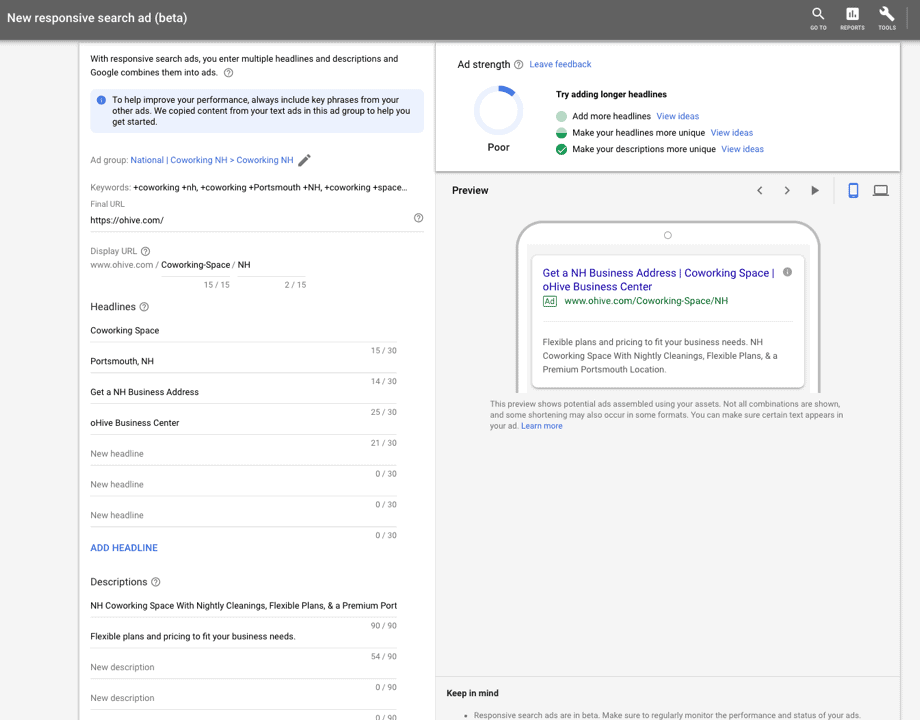
Display Ad Sizes (mobile & desktop)
There are sixteen different ad sizes that can be displayed on both Google and Google’s Display network. The most common formats are listed in the screen-grab below. Fore more information, Google has provided advertisers with a handle chart guide that you can view here.
The most common (and generally top performing) ad sizes are as follows:
- 300×250 – “Medium Rectangle”
- 336×280 – “Large Rectangle”
- 728×90 – “Leaderboard”
- 300×600 – “Half Page”
- 320×100 – “Large Mobile Banner”
With other common sizes listed below: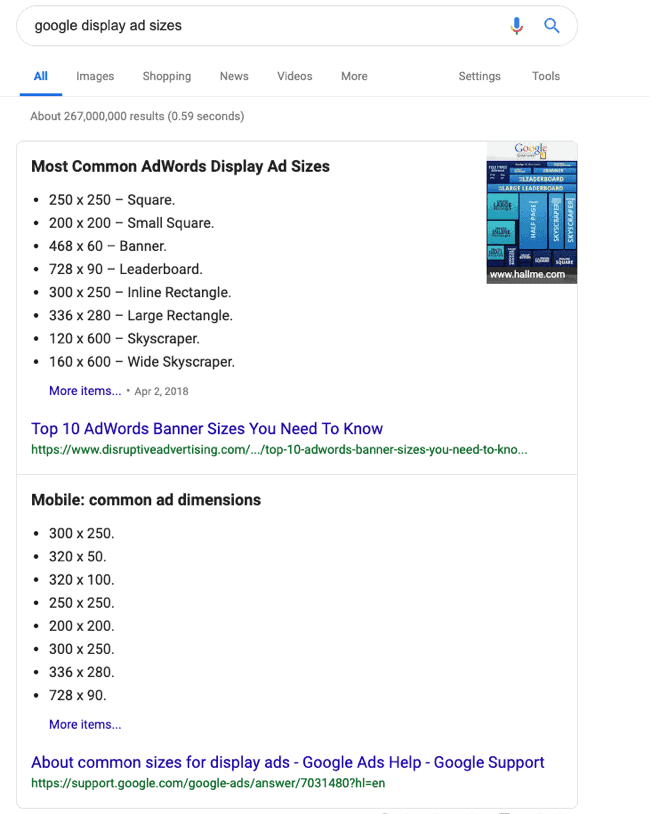
Responsive Display Ads
Similar to responsive search ads, responsive display ads allow advertisers to utilize Google’s machine learning algorithm to test different ad variations using images and copy to determine the best performing combinations. To setup a responsive display ad, you will need at least one landscape image (300×250) and a logo image that is 1:1 in aspect ratio. Responsive display ads allow up to five headlines and up to five descriptions to test. You will also need to include a final destination URL that you will send the user to once the ad has been clicked on. 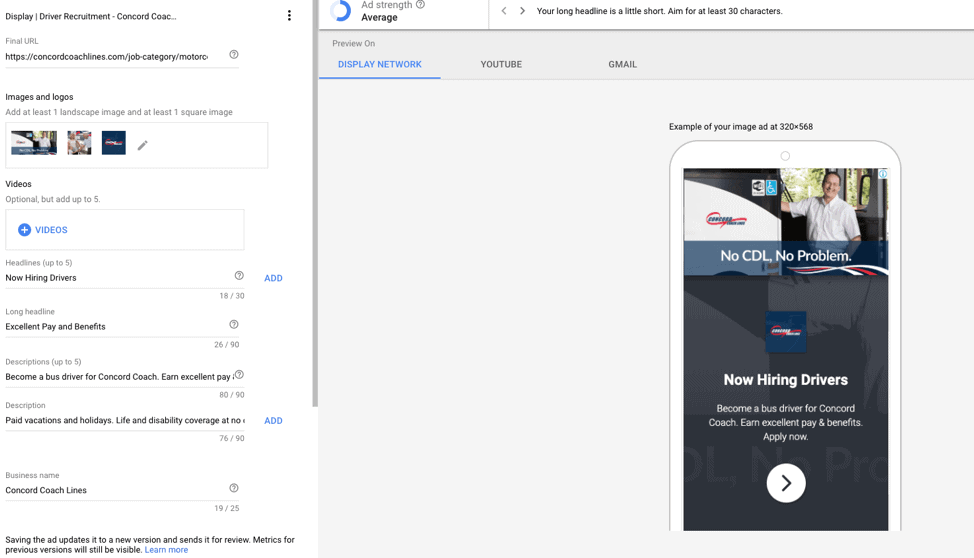
Call Only Ads
Call-only ads allow advertisers to serve ads that entice users to take action and call a business directly from the ad itself. These ads are great for local, service-based companies who drive business through phone calls in local geographic areas. A plumbing, electricity or pest control company who services the metro Boston area would be a great candidate for these ad types to help drive phone calls to their business.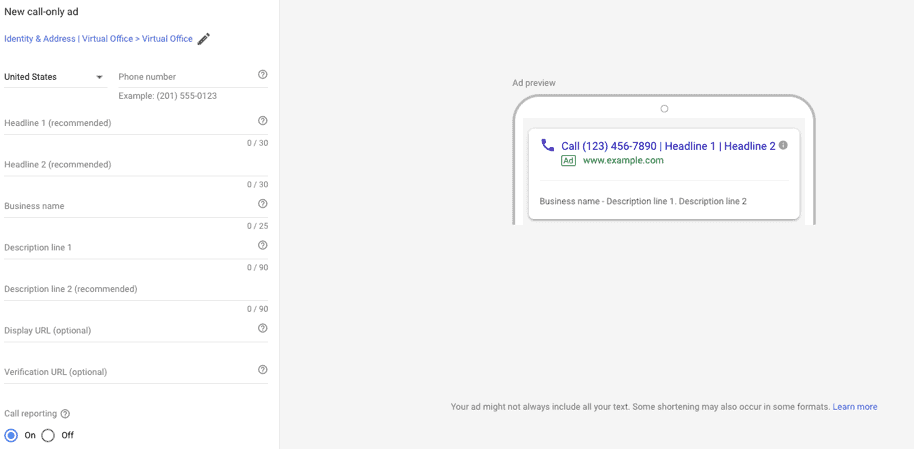
Ad Extensions
Call Extension — These extensions are great to promote users to call your business directly from your ad.
Location Extension — These extensions are great for promoting local service based companies and providing the nearest location.
Sitelink Extension — These extensions are great for promoting specific pages of your website. They act as other ways for users to click on your ads. Some examples of sitelinks are the contact page, hub page for a product line, support page, top sellers page, etc.
Structured Snippet — These extensions give more information about your business in the form of categories.
Seller Rating Extension — These extensions help give social proof (credit) to online sellers proving they have good product ratings and reviews.
Conversion Tracking
Conversion tracking is important in understanding what key actions a user took on a website after clicking on your ad. These actions could be form submissions (such as an email newsletter signup or a contact form), live chat conversations, add-to-carts, checkouts, purchases, etc.
Attribution is a key part of a paid campaigns performance as it allows an advertiser to set benchmarks for metrics such as click-through rate, conversion rate, conversions and cost per conversion. This will allow advertisers to see what campaigns are performing the best and make adjustments to further optimize and improve their performance.
Attribution can also help in determining ROI. Advertisers refer to this as ROAS (return on ad spend) or the amount of revenue generated that can be attributed back to an advertising campaign.
Types of Targeting
Device: There are now four types of devices you are able to target on Google. They are desktop, tablet, mobile and TV screens.
Location: This type of targeting is extremely granular. Google allows you to target down to the zip code level either by a radius or pin method. Advertisers can also place adjustments on their bids by location.
For example, if California and Texas are two top states that you sell to, an advertiser would want to allocate more budget towards these states to serve more often than other states. Advertisers can also include and exclude certain areas from serving ads in as well.
See image below of how granular it gets.
Account Structure
Advertisers begin by choosing keyword groupings and creating individual campaigns. For example, if you are a company who sells kitchen stools, you will want to create a campaign with a theme of “kitchen stools.” Within this campaign are themed subcategories, called ad groups. These ad groups may include:
- Square Kitchen Stools
- Round Kitchen Stools
- Tall Kitchen Stools
- Short Kitchen Stools
Each ad group then contains themed keyword variations. For example, the “Square Kitchen Stools” ad group may contain these keywords:
- Black Square Kitchen Stools
- Oak Square Kitchen Stools
- Home Depot Square Kitchen Stools
Management Tips for Account Optimization
Tip #1 – Identify Intent.
An experienced paid advertising manager or specialist will always try to drill down on intent of the user. By having a true understanding of the intent behind a keyword or search term, you can tailor your ad copy and landing page experience to this intent. Intent-based decisions will help you improve your ads click-through-rate (CTR) and improve conversion rate too. If you’re not careful, you could be seeing a ton of clicks on your ads but have a very low conversion rate. Messaging across ads and landing pages must be consistent and inline with why someone would take action to click on your ad.
Tip #2 – More Campaigns, Less Ad Groups.
Everybody knows that one account where they are four campaigns setup each with fifteen ad groups that cover an entire businesses services or products. Don’t be that person. You’re not only wasting budget but also choking budget from other campaigns from serving ads.
By having a few ad groups per campaign (ideally, we like to see one to two) you can effectively spread that campaign budget across each ad group. If one ad group is outperforming the other, that winning ad group won’t take away budget from the others. This type of account organization and strategy will help optimize your budget to evenly spend across every ad group effectively to whatever budget you set. No more ad groups limited by budget, no more choking out ad groups from spending budget. It’s a win-win strategy.
Tip #3 – Have a goal in mind.
Are you…
- Awareness focused
- Conversion (lead) focused
- Revenue focused
What’s the overall campaign goal?
Tip #4 – Make Data-backed Decisions.
Here at Vital, we don’t like making assumptions of “what will happen.” We like the numbers, we want to see the data. Every optimization is data backed. We look at both short term (one week to a month) and long term (six months to a year) data to make our decisions. We tell our clients, the first month of running any type of paid advertising campaign is a data collection period. In order to make any sort of changes to an account we need data to come in first. For longer term data-backed decisions, we look at trends in cost-per-click, location, keyword, conversion and other types of data.
Tip #5 – The Search Terms Report Is Your Best Friend.
When first launching a PPC campaign, review this report as much as you can to see what people are searching for triggers your ads. This data will help you determine if you need to add, eliminate or update your existing keywords. For starters, eliminate any bad terms that are irrelevant to your business. Place these terms in a negative keyword list (called negative matching) so your ads won’t serve for these search terms. Over time, adding negative keywords to your campaign will help improve your search terms report to become highly relevant.
Single Keyword Ad Groups (SKAGs).
A way for advertisers to gain more control over their account and achieve higher quality results from your Google Ads account. SKAG’s allows you to pair a single keyword to an AdGroup by using three different keyword modifier types. Below is an example:
- +custom +printed +shirts
- “custom printed shirts”
- [custom printed shirts]
This structure allows you to have a small number of keywords per ad group, while allowing for broader and high intent keywords to filter into your search terms report. You’re ads will serve on broader related queries through the usage of the broad modified match type while still serving for phrase and exact match queries. The SKAG technique takes a larger number of keywords and condenses that list into a mere three keywords.
By using this technique, you will begin to see your search terms report match your keywords and your click-through-rate (CTR) will skyrocket. Did you think just your CTR was going to improve? We’ll with an improved CTR will result in an improved quality score over time. With an improved quality score will result in better ad positioning, improved impression share and a lowered cost per click.
While structuring an account using SKAG’s you will benefit from lowering your overall cost per click and cost per conversion overtime. With all of these important metrics moving in the right direction, you’ll find that you’ll have to add less negative keywords over time, saving you time in optimizations and saving you money!
How Much Should I Spend on PPC?
PPC can be overwhelming. Where do I start? How much should I spend?
Paid advertising spend can be broken down into two parts: how much can you afford to spend on a single campaign (total ad budget) and how much you can afford to spend for a single action (click), also called a bid. Your total budget will be defined by your marketing budget. If you can afford to spend $1000, go for it. If you can only afford $500, that’s great, too.
Having a clear understanding of cost-per-result or cost-per-lead is huge in the attribution process. Advertisers want to provide a positive return-on-ad-spend (ROAS) to their clients. Nobody likes spending $1000 and only getting $250 back in return.
We understand lead attribution takes time and campaign and budget optimizations don’t just happen overnight. PPC is a fine-tuned process and requires a keen eye in order for it to work in your favor. But understanding how much a lead is worth to your business matters, and should be a key metric in your paid advertising and digital strategy. If you don’t know, how can advertisers have a benchmark to compare past and current campaign performance?
If you’re having trouble quantifying what a lead is worth to your business, we recommend taking a closer look at customer lifetime value (LTV). Don’t just think about how much revenue that one lead will bring in on the first sale. Consider how much your average customer spends over the lifetime of their relationship with you. Compare this number to your average conversion rate and you will be better informed on how much you can afford to bid.
Quality Score & AdRank
Quality Score is a key PPC metric that is based on three factors.
- Ad relevance (expected click-through rate)
- Quality of keywords (how closely related they are to your ad)
- Landing page experience (does the landing page message match the ad copy)
What is AdRank? Google determines an advertisers rank by determining their maximum cost per click and multiplying this number by your overall quality score. This is a key metric in determining ad position within the SERP.
Conclusion
Paid advertising, pay-per-click, PPC, paid media (whatever you want to call it) can be utilized for a wide variety of objectives. Depending on your focus, goals and strategy, it can be one of the most effective uses to gain brand awareness, drive online actions and increase sales revenue for your business. As you can see, PPC is no ‘walk in the park’ when it comes to optimization. There are countless variables that affect your campaigns and an experienced PPC specialist or manager will know which variables matter most to a business’s bottom line.
Have questions about anything mentioned in this post? Interested in learning more about Vital’s PPC process?
Contact us today to learn more about our PPC strategy.

